People often tell me that they find it difficult to take good portrait photos when they travel. Approaching strangers and asking to photograph them, usually with a language barrier, can be a daunting prospect. And how do you take a portrait that is creative and meaningful rather than just a simple snapshot of the person? I have developed approaches and techniques over the years to help become confident as a travel portrait photographer.
There are three ways to create a travel portrait:
1. Encounter people that you meet while exploring a place and ask to take their photo, usually after an initial interaction. This is how I’ve taken the majority of my travel portraits.
2. Organise a shoot by paying ‘models’ for their time which involves some kind of meeting and prior planning. I’ve done this on a few occasions, such as shooting the Masai in Kenya, the fishermen at Inle Lake in Myanmar, and some of the Amazon portraits in Brazil.
3. Shoot without any interaction with the person in a documentary/reportage style. Perhaps the most common approach, but it is hard to capture engaging facial expressions and there’s little control over the elements of the scene, which is why very few of my portraits are taken like this.
Let’s focus on the first method which is all about approaching people that you encounter while traveling.
Interaction
It’s important to meet and spend a bit of time with people before bringing out the camera and asking for a photo. I try not to show any photography gear when exploring new places so as not to create distance or set up any preconceptions during initial encounters. I use a sling style bag that houses my non-elaborate one camera and lens set up that I like to use (currently Nikon D800 with Nikon 24-85mm lens). I don’t travel with any flashes and rely solely on natural lighting.
It does take time and patience to establish a connection with local people, and you might need to be with them for a while until the best possible shot presents itself or becomes apparent. It’s important to be traveling solo or with fellow photographers who are prepared to spend a long time in one place.
Making eye contact with people, smiling, interacting and being jovial is the key. Perhaps using gesture and expression, try to comment or ask a question about the person or the place they are in to start an interaction. This could be referring to the clothes someone is wearing, a game people are playing, or food someone is eating or selling, for example. Any opportunity to interact and establish a relaxed and informal atmosphere to develop personal connection is very useful before bringing out the camera. Learning some words or phrases in the local language can also be a good ice breaker. But it is the facial expressions and actions that are most important when you don’t speak the same language. Smile, engage and show interest in the local people you encounter!
Once this connection has been made, you could ask the person if it’s ok to take their photo (by using gesture and expression) and they will probably agree, whereas it may not have worked out if you hadn’t initially made this connection. It is also important to try to meet people who you don’t necessarily plan to photograph, as you never know what it might lead to. You may be invited into someone’s home, or toured around a place of work or ritual, for example. Being with your new local friend(s) it becomes easier to ask people you encounter for photos, because they will ask these people in the local language and help you out, making for a very useful way to get portraits of people you may not have otherwise met or felt comfortable approaching.
The most successful portrait photographs usually feature faces that are characterful, engaging, beautiful, interesting or unique. If you come across someone with a face that you think will be powerful in a photograph, try to imagine how you might photograph them and then try your best to engage with them or the people around them and then ask if you can take their photo. If you are smiling, polite and light hearted in manner, more often than not they will happily say ‘yes’. Then, it’s up to you to give a little bit of direction to collaboratively and quickly create the portrait that you envisioned.
Six Posing Ideas
When you have a person happy to be photographed, it is important to be ready with posing ideas in your mind. Instead of simply taking a photo of someone in the place and position they are already in, it is often better to move and direct them to some extent for a more artistic and powerful result. I always look around the space and think ahead, trying to find a good background while considering the light, and I roughly imagine the shot in my mind. This is also happening before I have anyone to photograph, which means I’m more prepared when shooting someone and I can move quickly and with confidence, which in turn keeps the experience enjoyable for the subject and they will feel comfortable following your direction.
1. Lean on a Surface
Have the subject lean on something, especially in close up portraits. This will make their posture appear relaxed and engaging. Standing straight and upright with the shoulders down may not engage the viewer quite so effectively. The surface can be a chair, table, and often I get the subject to sit down and use their knee to lean on. Leaning on something relaxes the person down and keeps them still, in a way that standing upright is perhaps more difficult and the subject is more likely to move their head or change expression.
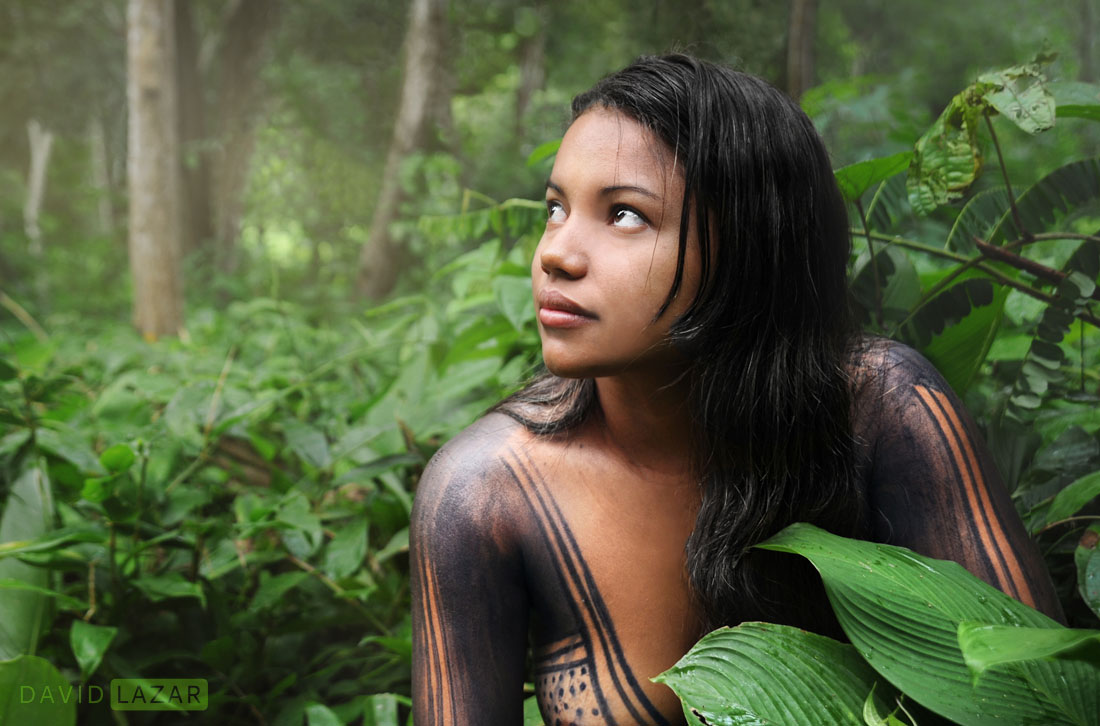
Taken while staying in an indigenous community in Maraba, Brazil, the young lady is leaning on her knee.
2. Interaction
It is good to have the subject touch or interact with something around them, preferably an object that says something about their culture or who they are. Physical interaction is also another posing idea I’m always thinking about, either with oneself or with another person. In this example, I’ve got the Masai boys to rest their heads on their hands and arms for a personal interaction as well as with the tree.

Members of the Dessana tribe near Manaus, Brazil, interacting with each other’s accessories and hair
3. Activity
Taking photos of people engaged in an activity can help make for images that tell a story. At times you may stumble on a person already doing the activity, and other times you will have to creatively construct the scene yourself. It is also possible to go one step further and organize a shoot, and usually this involves some payment for the subject’s time. Out if this, you can get great activity photos that you have full control over creating.
4. Expression
It’s good to capture a range of expressions in your portraits, and ‘smiling broadly at the camera’ type photos are nice but depict only one emotion. Often you will need to tell the subject what you want, and it’s good to demonstrate this so they can copy you. It’s interesting that by asking the subject not to smile, and therefore looking neutral and potentially expressionless, the subject can portray seemingly deep and reflective emotions in photography. Sometimes you might want the subject to look off camera, and in this case point to an area for them to look at. Try a few different angles as slight changes in head tilt make a big difference.
5. Object Close to Face
Having something close or touching the face in a close up portrait can be extremely powerful. This object could be many things, including material such as a scarf which creates a frame around the face.
6. Make a Pattern
Try to imagine a shape or pattern you could arrange your subjects into, for interesting and creative compositions.
Close, Mid or Wide
I usually make a decision if the shot will be a close up of the face that fills the frame, a mid shot of the person and some of their body or a wide shot of the person also showing their environment. Once I see the shot roughly in my mind – I can go ahead and create it.
The Eyes
The eyes are the focal point in any close up portrait. It’s important to frame them in one of the thirds, usually the upper third of the frame. They need to be clear and sharp. If you use autofocus on the camera and let the camera find a focal point, there is a good chance the camera will choose something else like the nose to focus on, but it’s paramount that the eyes have pinpoint focus. Here’s what I do – I have my camera on autofocus but on centre point focusing mode. Not only do I frame the eyes on the centre dot while it is auto focusing, I zoom right into the eye and aim the central point on the iris or eyelashes. Once that’s in focus, I hold it with the shutter half depressed, zoom back out, recompose the shot and take it. This is how I can aim to get the eyes as sharp as possible, alongside keeping the camera steady and making sure there is decent natural light on the subject.
Post Processing
Post processing of images is a very important step for me in the final creation of each photograph. Using Photoshop, I work on the photo to enhance light to my taste by brightening parts of the image and darkening other parts, done using adjustment layers and layer masks. In the same way I also work on getting the colours to be as complimentary as possible throughout the entire photo. This can involve boosting and decreasing saturation of specific colours on specific objects or areas of the photo, depending what needs to be done as I originally saw it in my mind’s eye. In the example below I removed the shades of blue from the plate, eyes and wall behind (reflections from the sky), brightened the lady’s face, eyes and clothes, and darkened the background. I always like to keep certain lines and some shadows very dark on the face, to contrast alongside the strong brightening to give definition and clarity to the subject.
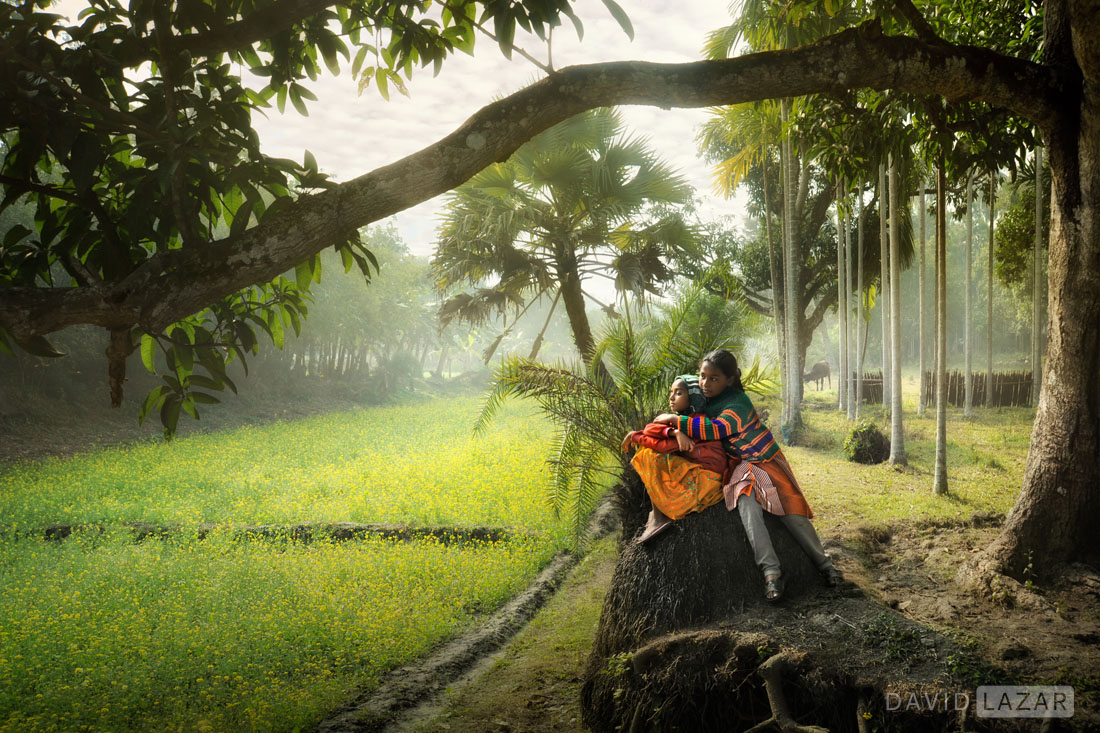
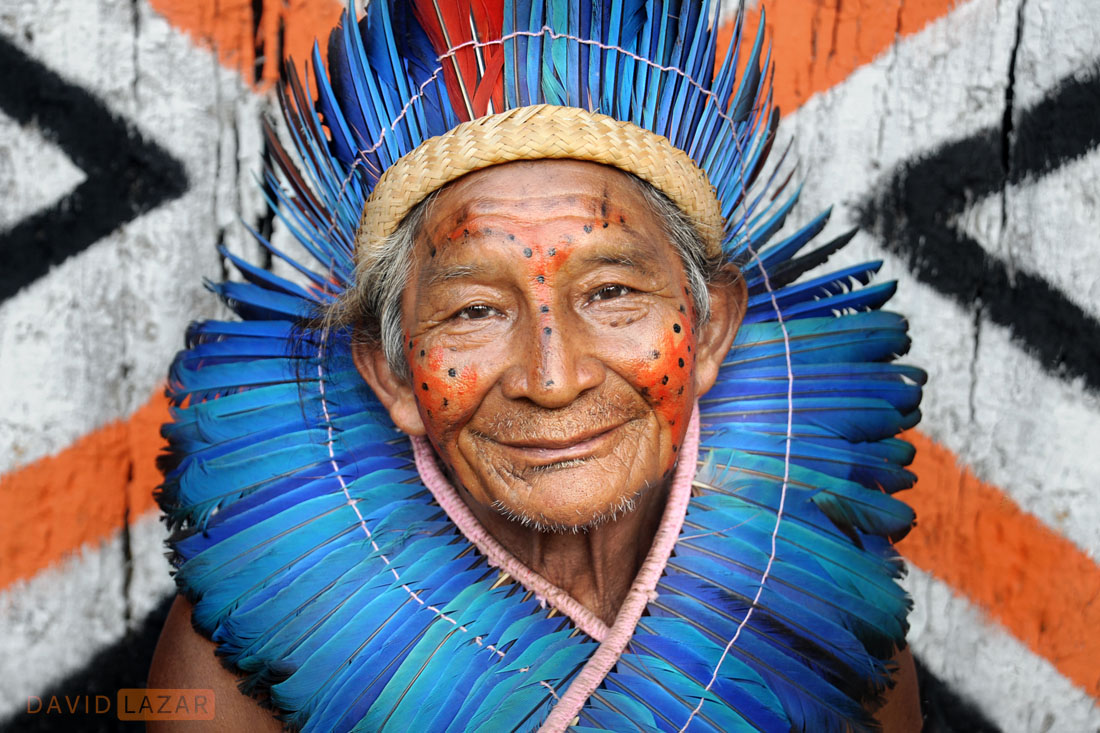
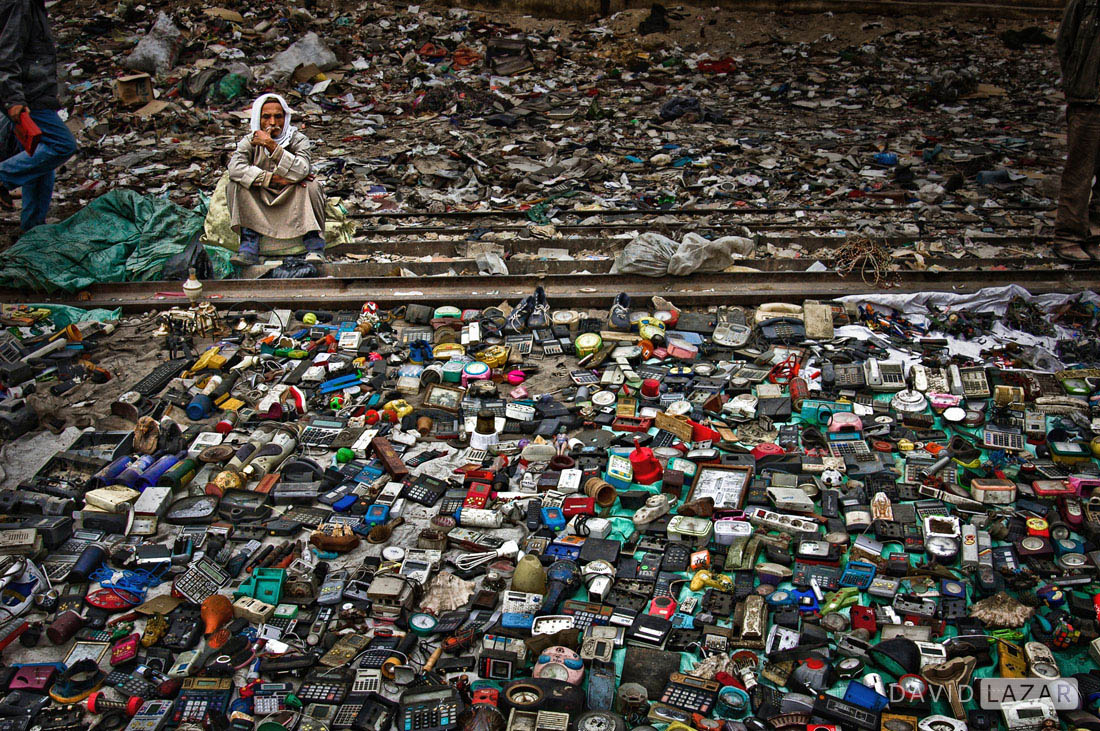


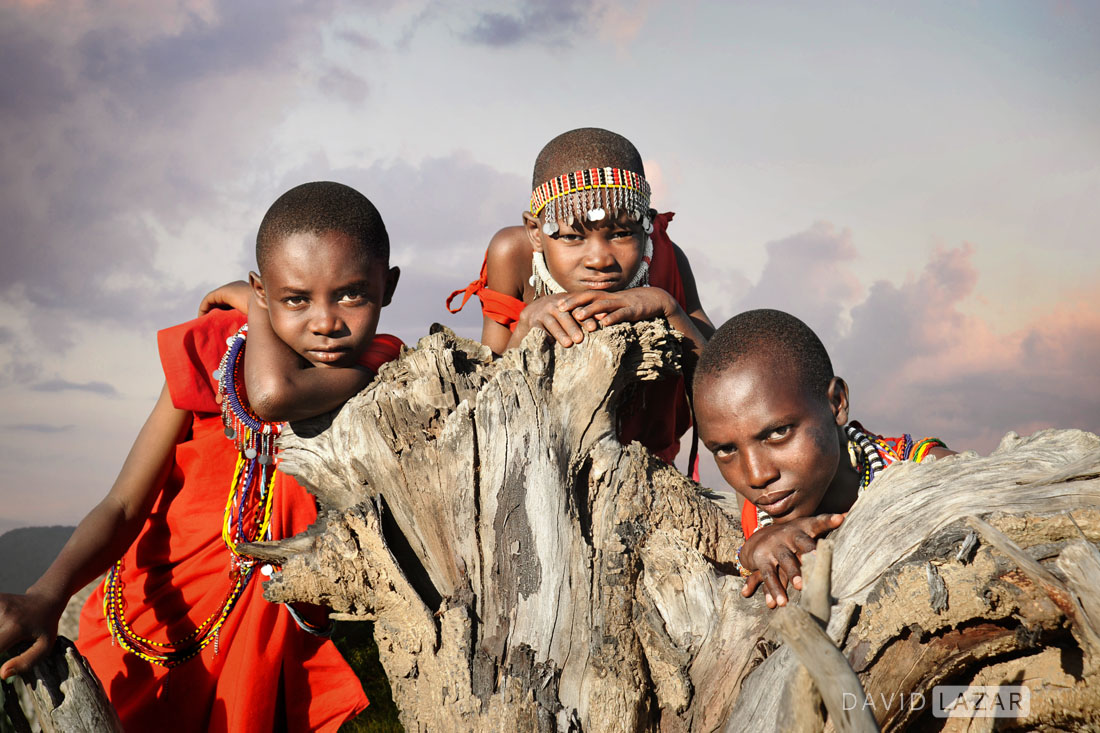



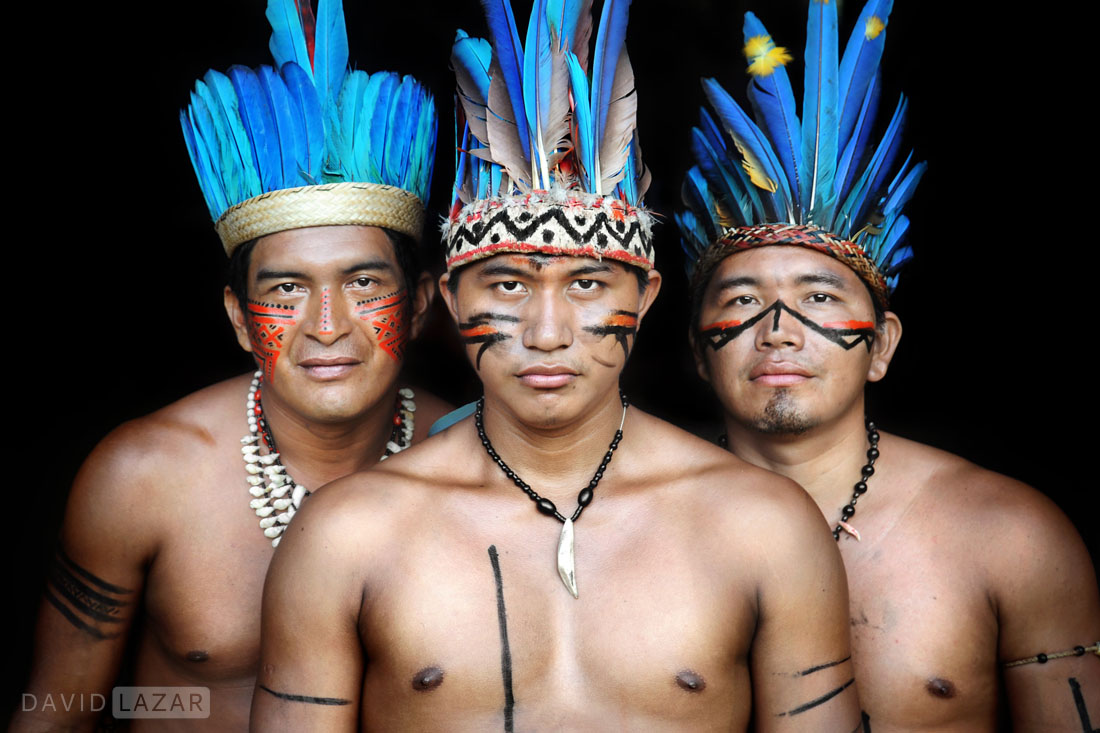
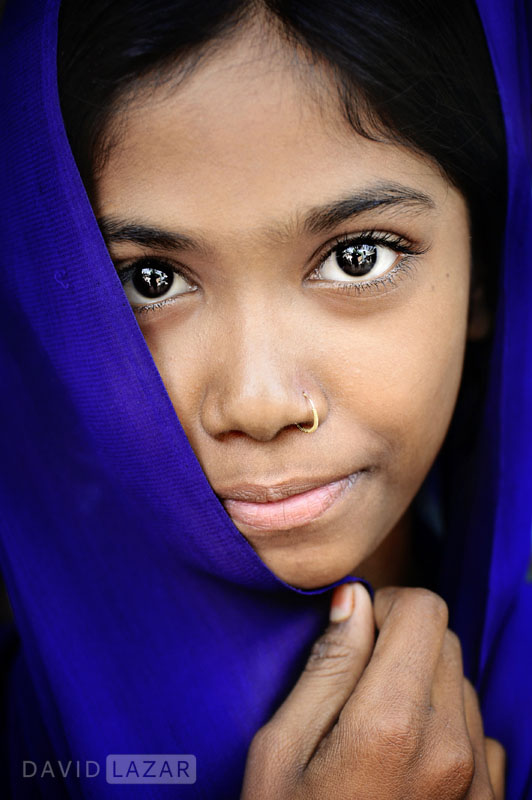





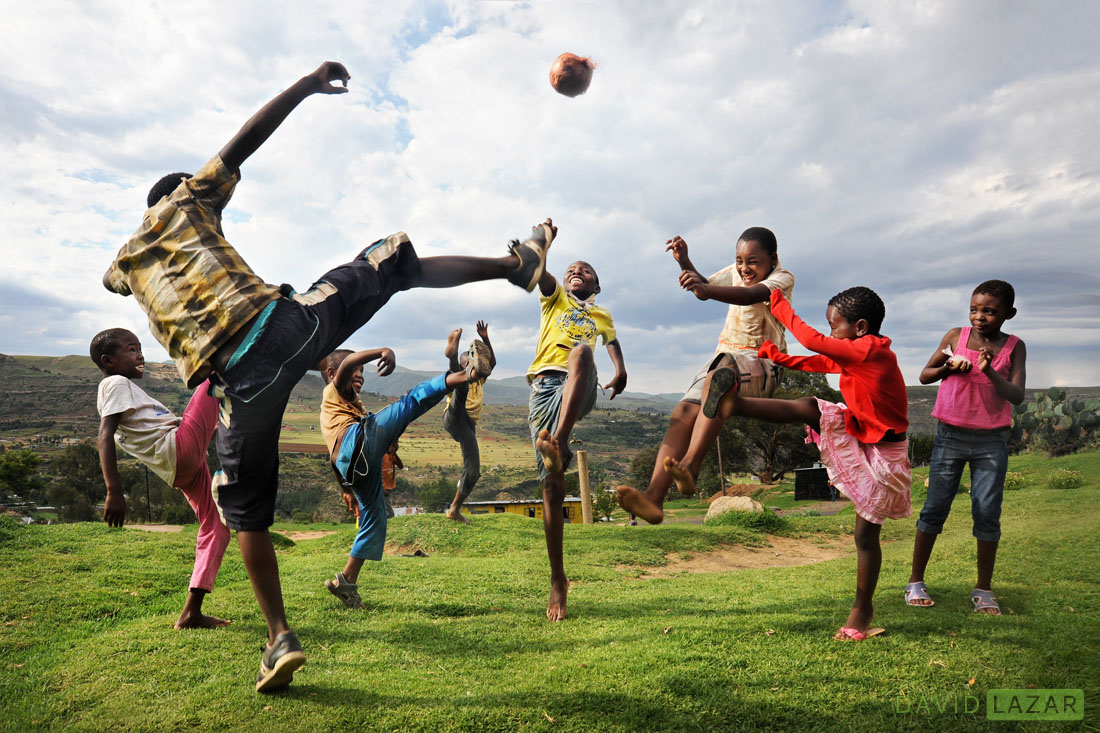
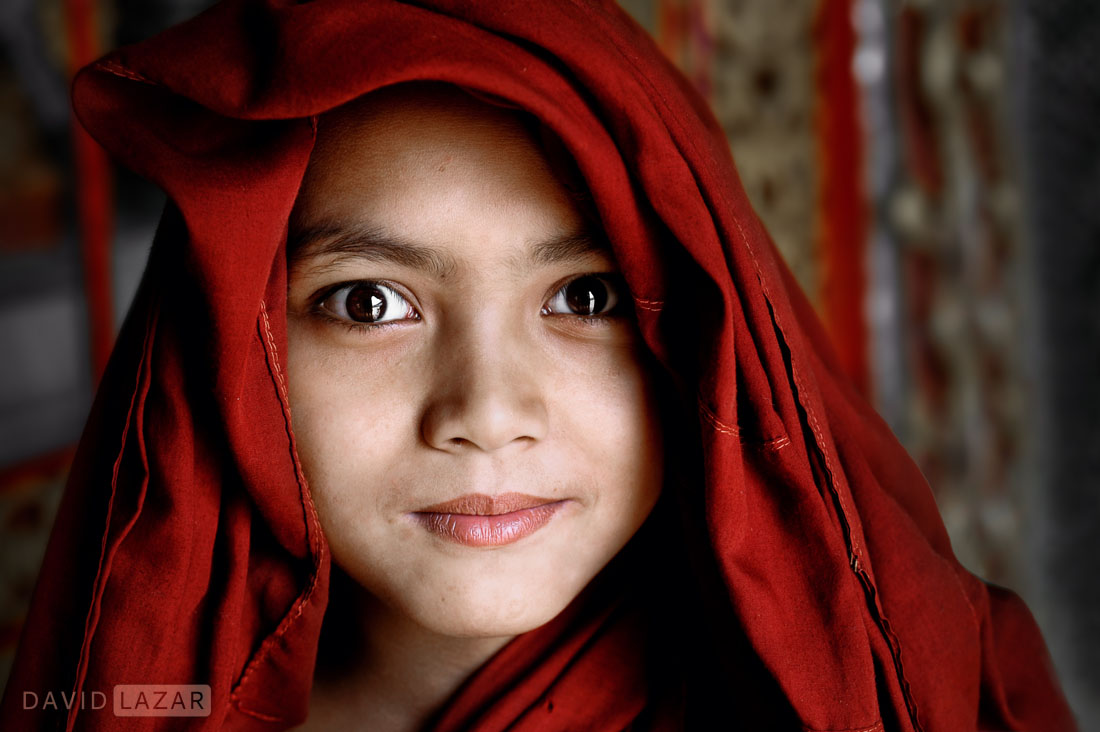
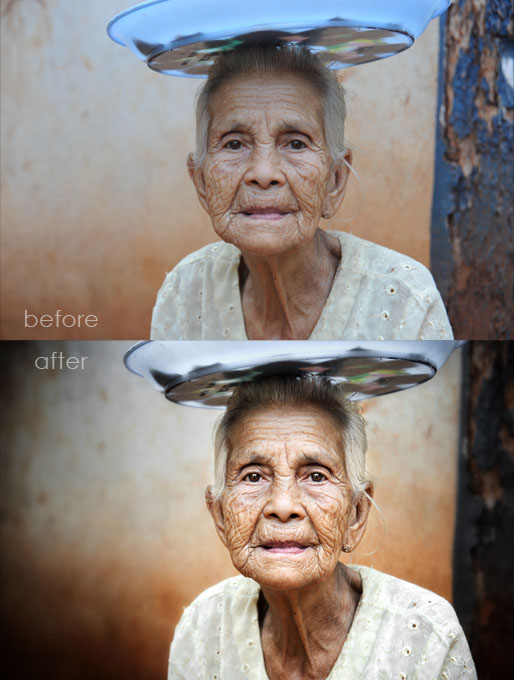
Very good,honest,helping suggestions.My only humble suggestion to you that crop with extreme caution,example of 3 peoples portrait the colorful blue feathers are cut.Try to include whole face with expression.Hope you will agree with me.
Thanks for your comment. In the photo with the blue feathers – the whole faces with expressions are included – it’s just the tips of the feathers that I cropped because we don’t need to see them and I would rather be closer to the faces than see absolutely everything.
Wonderful! I love this pictures. The best I have ever seen.
(y)
Agree with you, the face is more important, above all the eyes and smile. It’s incredible, but almost every photo you made is a chef d’oeuvre, a potent form of emotional communication. David, you are a talented guy and I like your art. Keep up the good work!!!
Thanks heaps Rob – I try to maintain a consistent standard in every photo!
I am a big fan of yours. Your pictures are absolutely stunning. it would be great if you could do one on post processing only and the techniques you use. especially some of your famous pictures.
Thanks RM – yes that’s a good idea for a future blog post topic – will keep it in mind.
Great advice David, thanks so much for taking the time to share. You are truly a master of the craft.
My girlfiend and me appreciate you sharing like this. We love so many of your fotos.
Such inside chance for us less experienced shooters is so helpful. What impress most about the fotos was the “reportage” style. This is an excelent foto! But we r not sure why you make so few?
3. Shoot without any interaction with the person in a documentary/reportage style. Perhaps the most common approach, but it is hard to capture engaging facial expressions and there’s little control over the elements of the scene, which is why very few of my portraits are taken like this.
Because “difficult” you take so few? “Control”? Photogaphs with control can look not so natural. Many great ones like Cartier-Bresson make great art out of giving up so much “control”. He let the magic patience and keen eye to make his decisive moments. Okay, another time. Things move so fast now. Need to make things happen nowdays.
You are inspiring to us and so many David. What is next for you? We wonder if you can share?? Is it true you are only 25? OMG! We look forward to see your work grow and evolve as time goes on. It will be very nice for sure!
Thank you so much for such a thoughtful blog post.
Reportage style is great and can be very powerful of course – but it’s harder to do it well because it takes a lot of time being out there trying to find those scenes, whereas meeting people and constructing a shot idea that’s in my mind yields more good quality photos in a shorter time (traveling comes with a time limit, at least for me because I live in Australia!). Light and people’s expressions are hard to get in your favour if you’re just walking around trying to get the scene as it is, at least for my style of shots. Also, in the case of close up people photography, I’m more comfortable knowing that the person I am shooting is happy to be photographed.. I can’t imagine just walking up to someone and sticking a camera in front of their face without any acknowledgement to them – and the result would probably be an uncomfortable or confused expression that wouldn’t work anyway!
It’s certainly an interesting point though – and I think it comes down to a stylistic thing and I know what works best for me and what I want to create and capture 🙂 Having said that – I sometimes do get good moments captured in the reportage style but it’s just not the majority of my work and I do like having a photographic style that’s unique to me. Thanks for your feedback! And by the way I am not 25, but just over 30.
Well done David !
Superb blog ! 🙂
Thanks for you tips David.
Thanks a lot for sharing your way of working, it is a great inspiration and teaching to me. And the pictures are just excellent.
One question though: how do you manage model release ?
You’re welcome Veith – and about model releases I don’t get them. The only limitation I’ve come across is companies like Getty Images not accepting them without releases and that’s totally fine with me.
Fantastic images David. I’m not surprised you’ve been picked up by Nat Geo. Your portraits remind me of Afghan Girl by Steve McCurry. How do you get such perfect light for your portraits?
Cheers Aaron – I get nice light by moving the subjects into shade, or make sure to wait until it’s cloudy and not harsh, direct sunlight on the subject. I capture the shot in even light and then brighten and darken more in Photoshop to get the stronger tones to make certain elements stand out better in the shot.
Thanks for this, David. Very informative.
Really enjoy your work, very inspirational.
Fantastic photos! Greatly enjoyed your thoughts on interacting with the people you photograph. I see so many people taking photos of folk as if they were furniture. Nowadays, when powerful zoom lenses are common, it’s disturbing to see fellow travelers abuse this “distance” to get portrait photos of people who have on clue they will soon show up on a stranger’s blog or facebook feeds. I use a (lousy) camera with no zoom, so have to get very close to people in order to take their photo. Since I prefer to be respectable of other people’s privacy (and would rather not get punched in the face), this means I nearly always ask permission (I’ve done a couple of “reportage” projects where I just shot away and hoped for the best). Good luck and safe travels!
Thanks Lunaguava.
Yes I guess it’s a personal thing how you approach this – if someone started taking a number of photos of me on the street and hadn’t asked me first – it would probably make me feel a little uncomfortable. So I don’t do that to other people. And conversely – if someone came up to me and asked if they could take my photo I will most probably say ‘yes of course, sure!’
Wow, great photos! thanks for sharing all these thoughts. It´s a good point about making contact before taking the photo. I have seen so often, that people just took the photo without showing respect, as if they made a photo of an object instead of a human being….
Nice David…. well done
I am really impressed…
In my childhood i am interested to photography. i can’t do this for many reasons.but i wish one day i can do this…
Truly a helpful article sir! I am a fan and still follow your works. You are truly an inspiration among aspiring travel photographers.
Sir if you may, I forgot to ask. With the D800 you are using right now, how do you compare it to your previous camera gear? Thanks!
My previous camera gear was Nikon D700 and before that Nikon D70. The D800 is similar to D700 but shoots in a higher resolution which is the most important difference for me, and it also has perhaps a better design, screen and it can do video.
David, just a question I have not clear enough. Have you never had any kind of problem with your ‘models’ or their families about image rights? Do you feel free of publishing all your photographs without any permissions? Even if they are minors? Thanks in advance.
No this has never been a problems. I’m not using their images to sell a product, such as in an advertisement.
Wow, just recently discovered your photography. Thanks for the excellent breakdown of your approach and technique. The faces with smooth skin tones combined with sharp eyes is fantastic and communicates so much beauty and humanity.
Thanks Matt.
Hi David, my congrats for your beautiful portfolio. I really love your work, you are such a great artist! I have a question: National Geographic asks, always, model realeses when the subject is recongizable. How do you manage it? It’s such a problem, I have some shot taken in Tanzania that I would submit to Nat Geo, but I can’t because I have no release. Thanks and congrats again!
HI David,
Your photographs are really great. i would like to know more about the post processing method. Even i want to learn more about photography.
hey,
it’s just awesome ..!!!
sir ,I am not professional photographer but it’s my dream to learn photography .
here I have learnt some tips from your post and it’s really helpful to me.
I’ll try to follow it.
and there is question ,is it necessary to have any degree for photography?
Personally I did not do any study of photography, I taught myself and developed the skills over time (since about 2005).
David,
i am your fan to..
i really enjoy your work david, Superb blog and site! 🙂
Thanks and love!
Great stuff, I know this dates a bit but I am curious about your « zoom in, focus, zoom out » tip. I always thought this worked well with video and specific parfocal lenses but not so well with DSLR because the focus point moves slightly when you zoom in or out. I admit I never really tried it extensively either and the results you are getting seems pretty sharp.
When you zoom in, focus and hold the focus, and then zoom out, the focus point doesn’t change on zooming back out. It will only change if you physically move forward or backward yourself.
Nice work bro
Hello David, I am a big fan of your work. You are one of my favorite photographers!
You show us this “zoom in, focus, zoom out” technique. If you are using a prime lens, how you get this really impressive sharp eyes?
Thanks Juliana. Yes you can’t do this technique on a prime lens – you just have to focus on your subject and make sure you don’t shake the camera and that there’s enough light for the photo to be sharp (and that the subject doesn’t move too much!). My lens which I shoot the majority of my portraits is not a prime lens, they’re basically all taken using a Nikon 24-85mm lens that I’ve had for a long time and I like it.
Hey….. I was just wondering who and what influeneced you to become a photographer and how did you began your caree in photography?
These photos are better than life 🙂 That’s what inspires people to visit other countries – a quality photo, balancing on the thin line between casual and professional photo. You can’t get it with Photoshop only – it really takes hundreds (I believe) of shots, to catch this exact moment when sun / model / scene are in this breath-taking combination which present on your photos.
Great job. Thanks!
That’s true Serge – thanks for your insight and support of my work.
It’s beautiful. If I want to rest I come here in your blog. I use one of you photo’s in my blog, I was inspired by it to write a poem. I hoop you will like it. bye
I’m Sam from India… I like you photography and I have taken your name as my master in my final project for my college… Can you please tell your techniques which you used
It is always great to come across a page where the admin take an actual effort to generate a really good article. Check out my website Webemail24 concerning about SEO.
I like the comprehensive information you provide in your blog. The topic is kinda complex but I’d have to say you nailed it! Look into my page Seoranko for content about SEO.
Superb posts! Have a look at my page Articlecity where I also put in extra effort to create quality information about Website Design.
Having read your posts. I believed you have given your readers valuable information. Feel free to visit my website 87N and I hope you get additional insights about Cosmetics as I did upon stumbling across your site.
Hey there, I appreciate you posting great content covering that topic with full attention to details and providing updated data. I believe it is my turn to give back, check out my website QH9 for additional resources about Content Writing.
An interesting topic and I’m glad to come across your page where I found some helpful insights. Check out my website QN5 too, if you need additional resources about Thai-Massage.
For anyone who hopes to find valuable information on that topic, right here is the perfect blog I would highly recommend. Feel free to visit my site QH7 for additional resources about Thai-Massage.